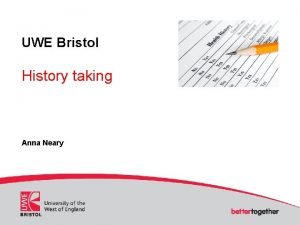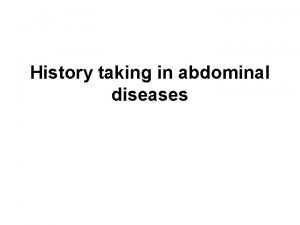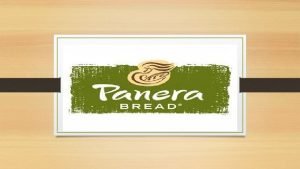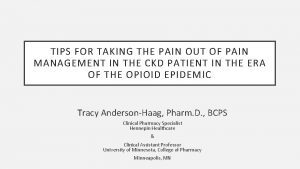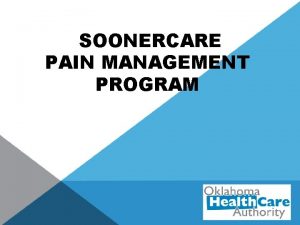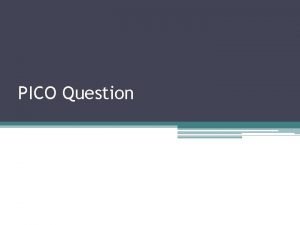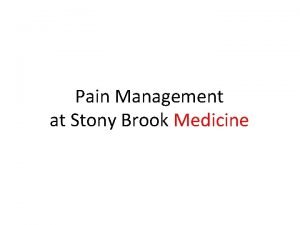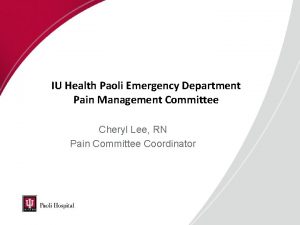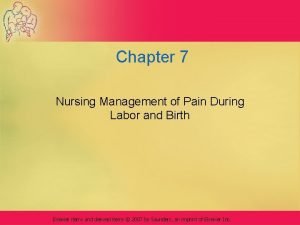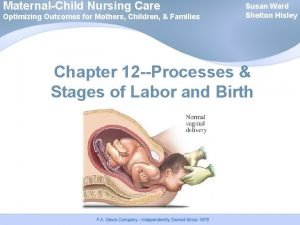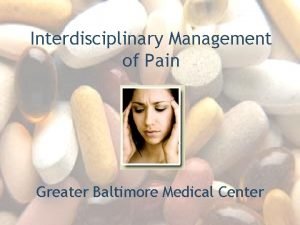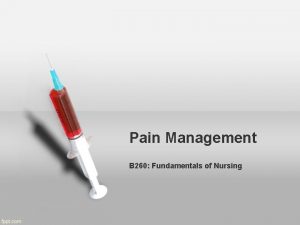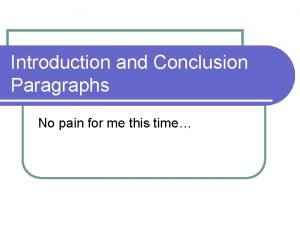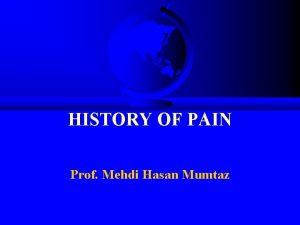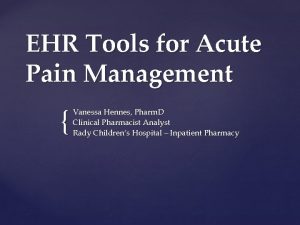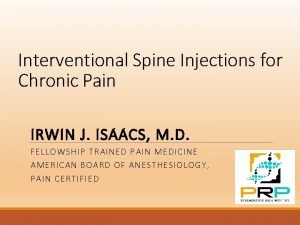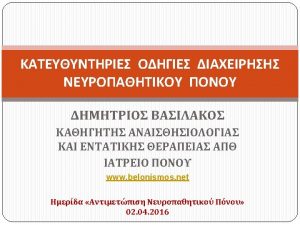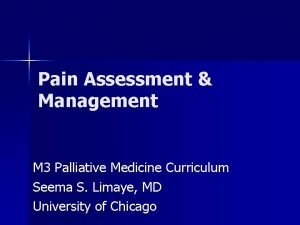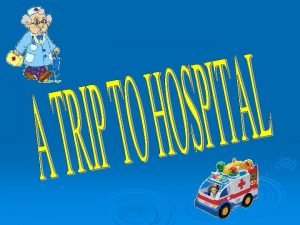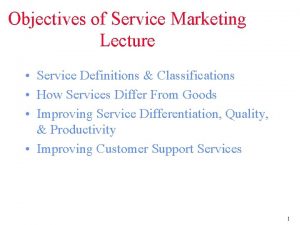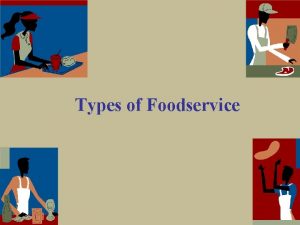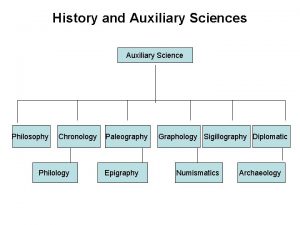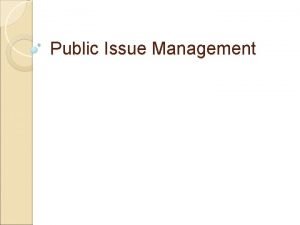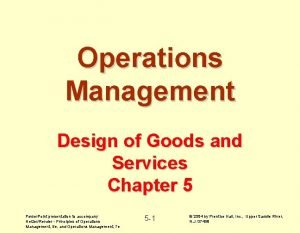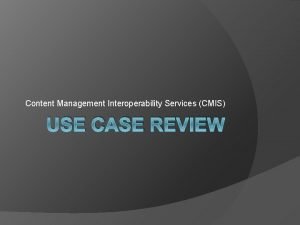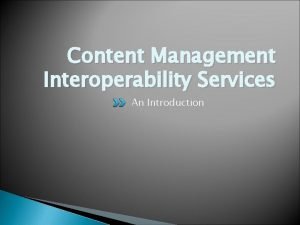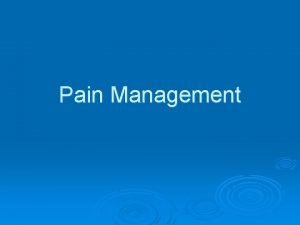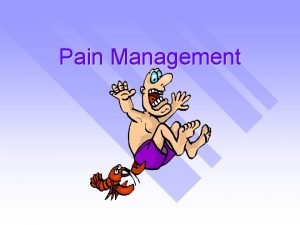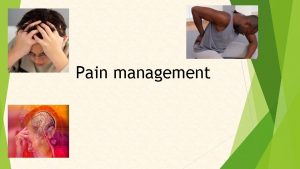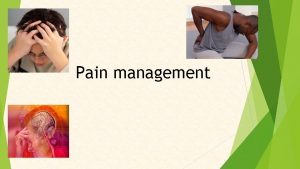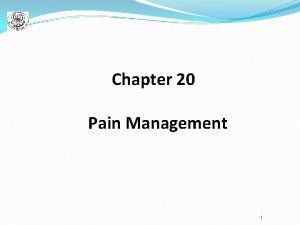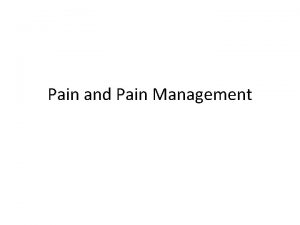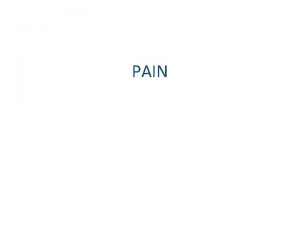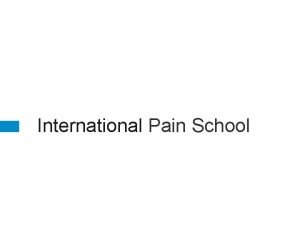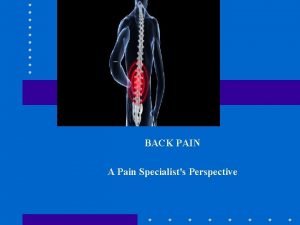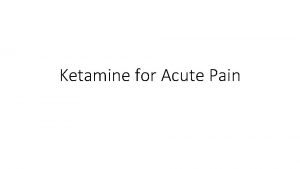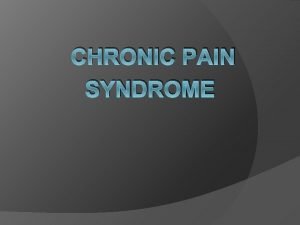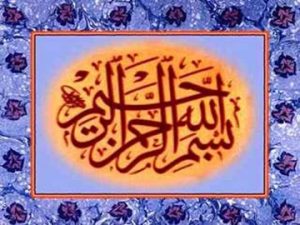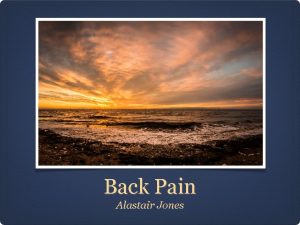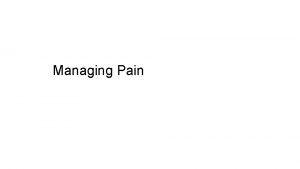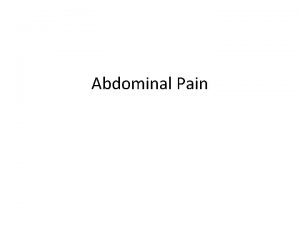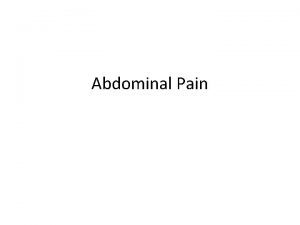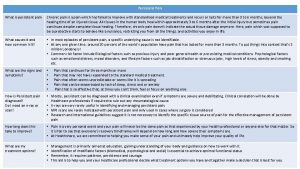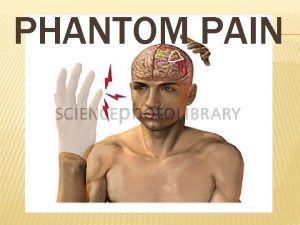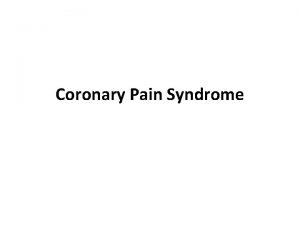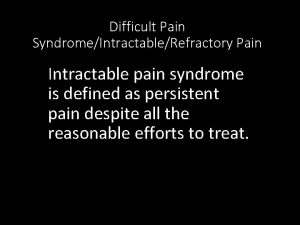History Types of pain Pain Management Services Pain













































- Slides: 45

History Types of pain Pain Management Services Pain Control Strategies Sympathy is not enough






A Brief History of Pain MARC LALLANILLA, 2005 HISTORY The Greek goddess of revenge, Poine, was sent to punish the mortal fools who had angered the gods Poine also gave us our word "pain" Many ancient cultures believed pain and disease were punishment for human folly. They tried to appease angry gods with rituals like votive offerings and scapegoats, sacrificial animals that carried the sins of people out into the wilderness One of the first pain theories involved Homer (8 th century BC) who described pain as “arrows shot by Gods”. Aristotle (384 BC – 322 BC) stated that Pain was due to evil spirits and that the gods entered the body during injury. The brain was not believed to have any direct influence and for years the liver or heart was considered to be the center for pain control. Many cultures and societies have developed their own theories regarding pain, including causations from deities, energy fields, the moon, and the stars

Holes in the Head (Incan, South America, Hippocrates, the ancient Greek physician, trepanation, ) willow bark and leaves from earlier cultures, and he prescribed chewing willow leaves to women in childbirth His prescription was not without merit -- willow trees, members of the plant genus Salix, contain a form of salicylic acid, the active ingredient in aspirin

The Egyptians used to take electric eels out of the Nile and lay them over the wounds of patients Transcutaneous electrical nerve stimulation, or TENS, is a popular treatment for lower back pain and arthritis aches In the medieval era, pain relief came mainly from a wide variety of herbs popular concoction was known as theriac It was usually prepared in a honey base with about 64 different compounds in it. Some of those herbs contain opiates Minerals were also used in the medieval pharmacopoeia: gold, ivory, unicorn horn Early 1900 s some physicians used gold salts injected into limbs to treat arthritis

Rene Decartes (1596 – 1650), the father of the Cartesian Model of Pain described pain as a stimulus created by the tissues as the origin of pain and the tissues send pain messages to the brain Examples of treatments that are based on the Cartesian Model of pain include epidurals, other types of nerve blocks, and cortisone injections Ronald Melzack knew that the Gate Control Theory was not complete because it does not explain various conditions including phantom limb pain One explanation involves the memory of pain that is stored in the brain. This memory can involve emotions, movements, even the time of year to trigger a painful response

Pain Management in the late 18 th century

The first new significant treatment for pain occurred in 1846 with the use of anesthesia for surgery Queen Victoria was really the first one to have anesthesia for childbirth In 2001 Ronald Melzack described the Neuromatrix Model of Pain Treating the Whole Patient

Definition IASP “Pain is defined as an unpleasant sensory and emotional experience associated with actual or potential tissue damage, or described in terms of such damage. ”

TYPES OF PAIN ACUTE l Post-operative l Obstetric - Labor l Burns l CHRONIC > 1 -3 mts l l Causes Trauma Cancer pain l l l Non-cancer l Infective / Inflammatory conditions l Ischaemic pain l Visceral pain l l Cancer related From cancer therapy Cancer unrelated l Nociceptive Neuropathic Idiopathic

TYPES OF PAIN

TYPES OF PAIN NOCICEPTIVE Somatic NEUROPATHIC Visceral • Organs – heart, liver, • bones, joints • connective tissues pancreas, gut, etc. • muscles

Nociceptive: Somatic Pain Descriptors: aching, deep, dull, gnawing n Distribution/Examples: n – Well localized—patients can often point with one finger to the location of their pain • bone mets, strained ankle, toothache n Analgesics: NSAIDS, acetaminophen opioids Quality

Nociceptive: • • Somatic Pain Aching, often constant May be dull or sharp Often worse with movement Well localized Eg/ – Bone & soft tissue – chest wall

Nociceptive: Visceral Pain • Descriptors: cramping, squeezing, pressure • Distribution/Examples: • Referred • heart attack, kidney stone • Colicky • Bowel obstruction, gallstone • Diffuse • Peritonitis • Analgesics: opioids; acetaminophen Quality

Nociceptive: • • Visceral Pain Constant or crampy Aching Poorly localized Referred Eg/ – CA pancreas – Liver capsule distension – Bowel obstruction

NEUROPATHIC PAIN features COMPONENT Steady, Dysesthetic DESCRIPTORS • Burning, Tingling EXAMPLES • Diabetic neuropathy • Constant, Aching • Post-herpetic • Squeezing, Itching neuropathy • Allodynia • Hypersthesia Paroxysmal, Neuralgic • Stabbing • trigeminal neuralgia • Shock-like, electric • may be a component of any neuropathic pain • Shooting • Lancinating


Pain Management Services Teamwork • ‘a distinguishable set of two or more people • who interact, dynamically, interdependently, & adaptively • toward a common & valued goal/objective/mission, • who have each been assigned specific roles or functions to perform, & • who have a limited life-span of membership’. Salas & Colleagues 1992.

• Multidisciplinary team (MDT) in the management of both acute and especially persistent pain • All facets of the pain are given equal importance in assessment and management • Research, audit, innovation, quality improvement attention to patient safety • High-quality pain services.

Multidisciplinary a service that involves several members from various health care professional backgrounds, such as medicine, nursing, physiotherapy, occupational therapy, psychology, play therapy.

Multispecialty a service with close collaboration and liaison between several medical specialities (for example, gynaecology, psychiatry, neurology, paediatrics) in assessing and managing a specific patient and usually joint clinics.

Consultants in pain management must work in environments which encourage team working and effective communication.

Basic Requirements for the MDT • Planning for team interventions and feedback, • scheduled MDT meetings, • departmental business & • governance meetings

Standards for acute and postoperative pain • Acute pain teams must include adequate numbers of appropriately trained doctors and nurses. • Where not available within the core acute pain service, there must be access to expertise in regional anaesthesia. Core Standards for Pain Management Services in the UK 2015

Standards for acute and postoperative pain • Close links with pharmacy services must be in place to ensure safe and appropriate prescribing of analgesics. • Pain Management services should have a unified governance and management structure to ensure that acute and chronic services work together in comfort. Core Standards for Pain Management Services in the UK 2015

Recommendations for acute and postoperative pain • Formal MDT meetings are desirable when managing complex pain cases. • These meetings should involve representatives from the patient’s medical team, chronic pain specialists, physiotherapists or psychologists. • Close links with other teams involved in pain management, such as palliative care and oncology, can result in improved patient outcomes. Core Standards for Pain Management Services in the UK 2015

Standards for persistent (chronic) pain The multidisciplinary team must include; • medical consultants trained in chronic or acute pain medicine • nurses • physiotherapists, • psychologists, • pharmacists • occupational therapists, • suitably trained GPs with a special interest (GPw. SI) • SAS doctors. Core Standards for Pain Management Services in the UK 2015

Standards for persistent (chronic) pain • The multidisciplinary team must communicate regularly and effectively with the patient’s general practitioner. • Resources must be available in terms of space and time for regular team meetings.

Standards for persistent (chronic) pain • The multidisciplinary and multispecialty team must have adequate administrative support. Clinical governance requires ongoing audit and data collection. • No sole practitioner acting in isolation, whatever their profession, can claim to run a pain management clinic or service. Any practitioner working single-handedly because of remote location must maintain formal links with colleagues/peers. Pain management services should be staffed and operate to accommodate the local requirements of all patient groups: • children, • adolescents, • the elderly and • those with complex needs.

Pain Control Strategies General Principles of Management • Set a goal of reduction of pain to tolerable levels, not a goal of complete relief • “Start low and go slow” • Make sure patient and family are aware of goals • Frequent clinic visits at first for assurance, validation, and monitoring of titration


Pain Control Strategies Pharmacotherapy Invasive approaches: q Anesthetic approaches q Implantable devices q Neurostimulation approaches q Surgical approaches Alternative approaches q Rehabilitative approaches q Lifestyle changes q Psychological approaches

Pain Control Strategies • Non Opioid Analgesics: • NSAA • NSAIDs • Non-selective COX inhibitors • Selective COX-2 inhibitors • Opioids • Weak Opioids. • Strong opioids. • Mixed agonist – antagonists • Adjuvants • • Antidepressants Anticonvulsants Substance P inhibitors NMDA inhibitors LA Drugs for Headache Drugs for Bone pain Others Pharmacotherapy

Pain Control Strategies Remember the common patient-related barriers to pain management • Drugs. . • are addicting • should be saved for when it is really needed • have unpleasant or dangerous side effects • pills are not as effective as a shot • narcotics are only for dying people Pharmacotherapy

Pain Control Strategies Adverse effects of opioids • Respiratory Depression • Sedation • Nausea and Vomiting • Pruritus • Urinary retention • Hallucinations Pharmacotherapy

Pain Control Strategies Invasive approaches • Therapeutic neuroblockade Peripheral Central neurolysis • Electrical stimulation TENS Spinal cord stimulation Intracerebral stimulation

Pain Control Strategies • Invasive approaches Implantable devises

Pain Control Strategies Alternative approaches • Alternative medicine: • • Acupuncture TENS Cupping Chiropractice • Physical Therapy • ice, heat, massage • Exercise • Psychological therapy • • Cognitive-behavioral therapy Relaxation techniques Biofeedback Hypnosis

Pain Control Strategies W. H. O. ANALGESIC LADDER 3 By the Strong opioid +/- adjuvant 2 Clock Weak opioid +/- adjuvant 1 Non-opioid +/- adjuvant Invasive approaches in a P t s i s r pe r o s s e s a e r c n i

Questions what kind of pain? burn injury fracture phantom limb arthritis myocardial infarction bowel obstruction
 Pain x mad
Pain x mad Can early pregnancy feel like period cramps
Can early pregnancy feel like period cramps Pms or pregnancy
Pms or pregnancy Presenting complaint
Presenting complaint Abdominal pain socrates
Abdominal pain socrates Au bon pain history
Au bon pain history Intserv vs diffserv
Intserv vs diffserv Wake county human services community services center
Wake county human services community services center Types of pain description
Types of pain description Socrates pain assessment tool
Socrates pain assessment tool Types of pain
Types of pain Also history physical
Also history physical Top management middle management first line management
Top management middle management first line management Management pyramid
Management pyramid Top level management
Top level management Pain management okc soonercare
Pain management okc soonercare Pico format question
Pico format question Stony brook pain management
Stony brook pain management Iu pain management
Iu pain management Chapter 7 nursing management of pain during labor and birth
Chapter 7 nursing management of pain during labor and birth Dr ruben gonzalez-vallina
Dr ruben gonzalez-vallina Fetal head
Fetal head Prizm pain management
Prizm pain management Matrifen
Matrifen Comfort and pain management fundamentals of nursing
Comfort and pain management fundamentals of nursing Dr danko pain management
Dr danko pain management Pain paragraphs
Pain paragraphs Dr. mehdi pain management
Dr. mehdi pain management Pain management ehr
Pain management ehr Vertebrae
Vertebrae Res pain management
Res pain management Dr lascarides pain management
Dr lascarides pain management Pain management synonym
Pain management synonym Classification of service marketing
Classification of service marketing Types of health services
Types of health services 3 types of community pharmacy
3 types of community pharmacy Types of services marketing
Types of services marketing Types of labour welfare services
Types of labour welfare services What are the types of food service
What are the types of food service Importance of auxiliary sciences in history
Importance of auxiliary sciences in history What do you understand about public issue management?
What do you understand about public issue management? Design of goods and services in operations management pdf
Design of goods and services in operations management pdf Faa eim
Faa eim Ortak portal
Ortak portal Content management interoperability services
Content management interoperability services Oclc worldshare management services
Oclc worldshare management services



